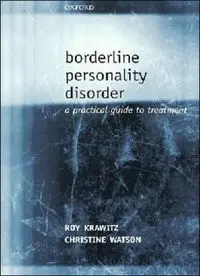
Borderline Personality Disorder: A Practical Guide to Treatment PDF
Preview Borderline Personality Disorder: A Practical Guide to Treatment
Borderline Personality Disorder Oxford University Press makes no representation, express or implied, that the drug dosages in this book are correct. Readers must therefore always check the product information and clinical procedures with the most up to date published product information and data sheets provided by the manufacturers and the most recent codes of conduct and safety regulations. The authors and the publishers do not accept responsibility or legal liability for any errors in the text or for the misuse or misapplication of material in this work. Borderline Personality Disorder A practical guide to treatment Roy Krawitz Consultant Psychiatrist to the area of borderline personality disorder, Health Waikato, Hamilton, New Zealand Christine Watson Director, Spectrum, The Personality Disorder Service for Victoria, Melbourne, Australia 3 3 Great Clarendon Street, Oxford OX2 6DP Oxford University Press is a department of the University of Oxford. It furthers the University’s objective of excellence in research, scholarship, and education by publishing worldwide in Oxford New York Auckland Bangkok Buenos Aires Cape Town Chennai Dares Salaam Delhi Hong Kong Istanbul Karachi Kolkata Kuala Lumpur Madrid Melbourne Mexico City Mumbai Nairobi Sa˜o Paulo Shanghai Taipei Tokyo Toronto Oxford is a registered trade mark of Oxford University Press in the UK and in certain other countries Published in the United States by Oxford University Press Inc., New York ß Oxford University Press 2003 The moral rights of the author have been asserted Database right Oxford University Press (maker) First published 2003 All rights reserved. No part of this publication may be reproduced, stored in a retrieval system, or transmitted, in any form or by any means, without the prior permission in writing of Oxford University Press, or as expressly permitted by law, or under terms agreed with the appropriate reprographics rights organization. Enquiries concerning reproduction outside the scope of the above should be sent to the Rights Department, Oxford University Press, at the address above You must not circulate this book in any other binding or cover and you must impose this same condition on any acquirer A catalogue record for this title is available from the British Library ISBN 0 19 852067 0 10 9 8 7 6 5 4 3 2 1 Typeset by Cepha Imaging Private Ltd. Printed in Great Britain on acid-free paper by Biddles Ltd, Guildford & King’s Lynn Preface The book focuses on work in adult mental health services, and does not attempt to cover specialist areas (e.g. child, adolescent and forensic services) or work with indigenous populations. Gender and sexual abuse issues are important, as 75% of people meeting diagnostic criteria for borderline personality disorder are female and 70% have a history of sexual abuse. These issues, whilst commented on, have not been comprehensively addressed in this book as there are ongoing forums available where they have been and will continue to be explored. R.K. C.W. January 2003 Acknowledgements Thanks to clients, colleagues, supervisees, and workshop participants for the knowledge and opportunities for learning they have provided. Thanks to the American Psychiatric Association for their permission to reprint the DSM-IV diagnostic criteria for borderline personality disorder and the Williams quote, Balance Program for providing the template on which the ‘‘Fictitious Example of a Crisis Plan’’ is based, Canadian Family Physician for permission to reprint the vignette ‘‘Molly’’, the Center for Psychiatric Rehabilitation for permission to reprint the item by Everett and Nelson, the Cutting Edge for permission to quote from their newsletter, Guilford Press for permission to reprint quotations from Rockland, Beck/Freeman & Associates, Leibenluft, Gardner and Cowdry, and Linehan, Jackson for permission to use several quotations, the Mental Health Commission for permission to reprint the section ‘‘Clinician values and feelings’’, and Williams for permission to adapt and print the exercise ‘‘Self-exploration of reasons for self-harm’’. Contents Terminology page xi Abbreviations xii ‘‘Molly’’ xiii Introduction xv Part 1 Background to treatment Origins of the label ‘‘borderline personality disorder’’ 3 History of treatment 4 Epidemiology 4 Diagnosis 6 Comorbidity 9 Clinical boundaries 11 Aetiology 13 Prognosis 15 Morbidity and mortality 18 Morbidity 18 Mortality 18 Health resource usage 19 Health resource use after effective treatment 20 Different treatment models 21 Psychodynamic and psychoanalytically informed psychotherapy 21 Self psychology 23 Relationship management 24 Cognitive analytical therapy (CAT) 24 Cognitive-behavioural therapies 26 Dialectical behavior therapy (DBT) 26 Commonalities between different models 29 viii BORDERLINE PERSONALITY DISORDER: A PRACTICAL GUIDE TO TREATMENT Multimodel approach 30 An organizing clinical framework for mental health clinicians 31 Outcome studies 34 Psychosocial treatments 34 Pharmacological treatments 40 Serotonergic agents 41 Neuroleptic agents 42 Anticonvulsants 42 Older agents (tricyclic antidepressants, older MAOIs) 42 Other agents 43 Prescribing in the acute situation 44 In summary 44 Part 2 Treatment issues and clinical pathways Introduction 49 Assessment 49 Risk assessment 54 Differentiating acute and chronic suicidal and self-harm patterns 54 Crisis assessment 56 Interventions 58 Client–clinician relationship 58 Team/system culture 58 Clinical plan 59 Duration of treatment 69 Prioritizing interventions 69 Empathy and validation 71 Containment/holding 72 Transitional people and items 73 Self-harm 74 Contracts 80 Crisis work 81 Regression at times of crisis 83 CONTENTS ix Some anti-suicide interventions 84 Acute inpatient services 85 Client-controlled brief acute admissions 91 Pragmatic conceptual frameworks guiding treatment 94 Cognitive behavioural strategies 101 Behaviour chain and solution analysis 107 Teams 112 Team structure 112 Investing value and status in the key clinician role 114 Specialist teams 115 Systems 116 Responsiveness of the organization to clinician needs 116 Staff differences 118 Residential treatment 123 Relatives and friends 125 Principles of effective treatment 127 In summary 128 Part 3 Stigma, language, clinician feelings, and resourcing Stigma and discrimination 133 Language – negative terminology 134 Clinician values and feelings 135 Resourcing 137 In summary 138 Part 4 The legal environment Medicolegal framework 141 Duty of care and institutional responsibilities 142 Professionally indicated risk-taking 145
